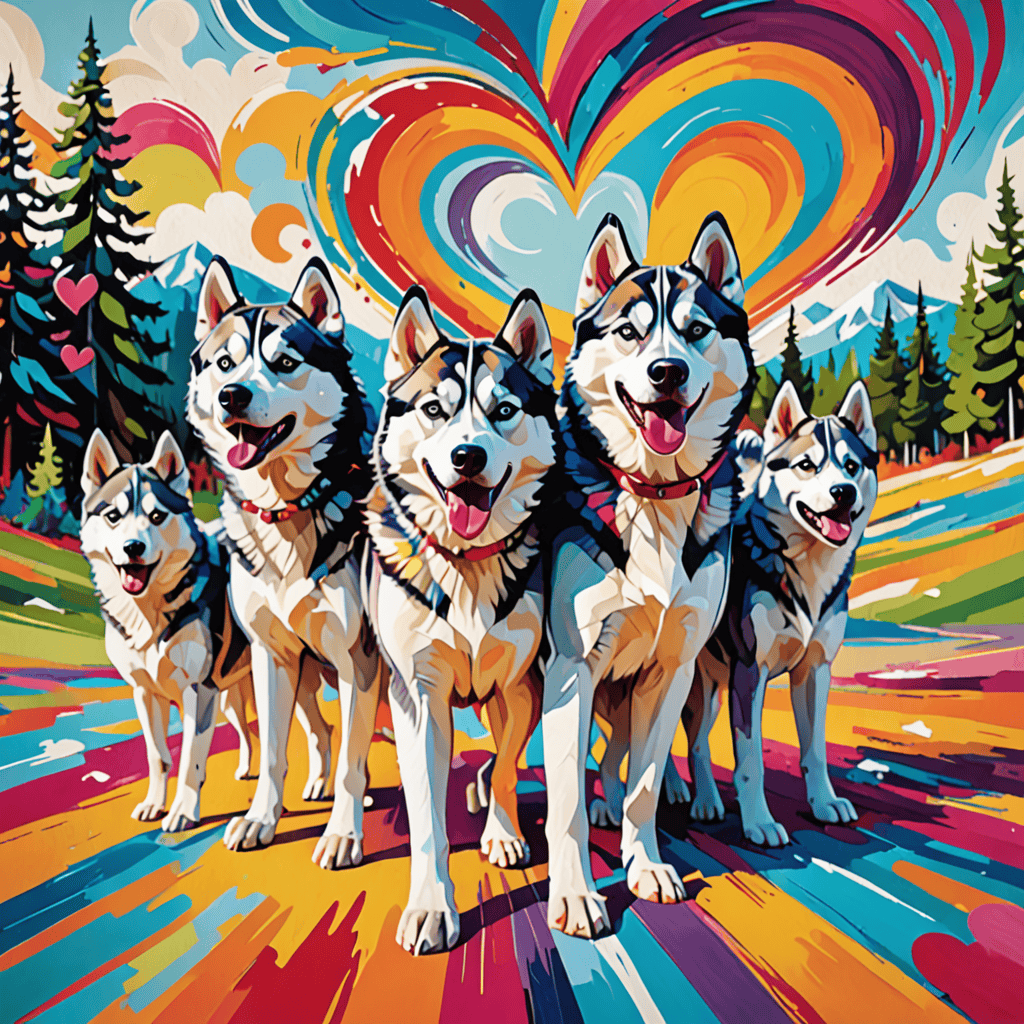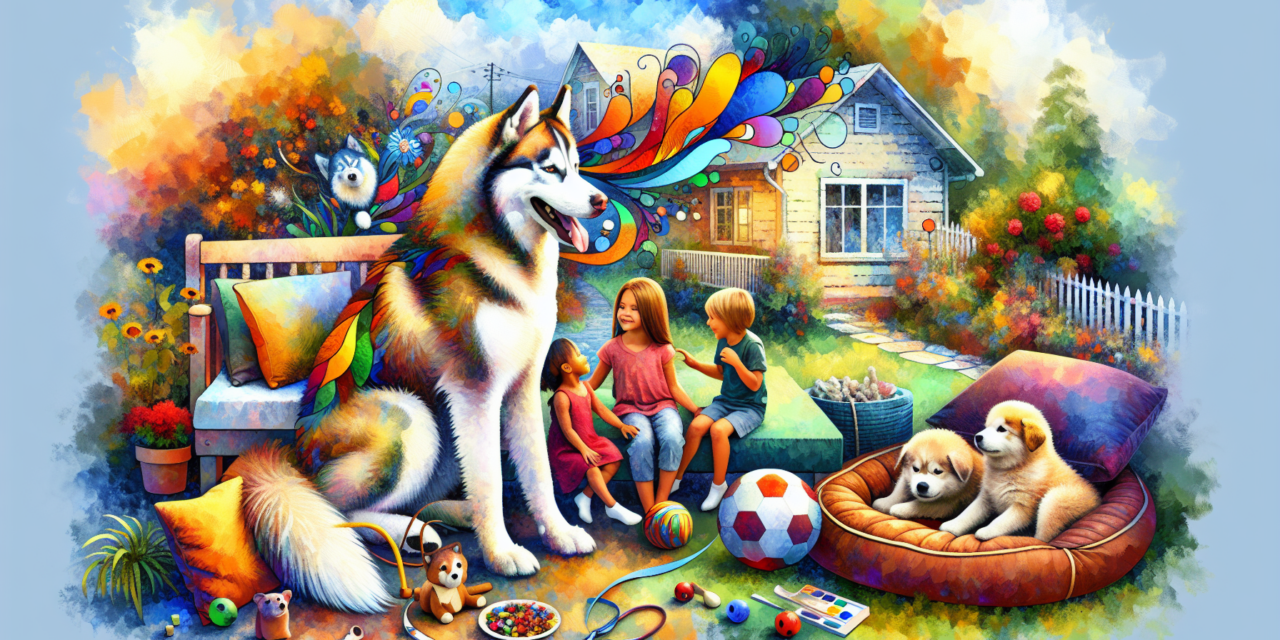Are you considering adding a husky dog to your family? The husky dog breed, particularly the siberian huskies, has gained immense popularity due to their striking appearance and vibrant personalities. However, before making this commitment, it’s essential to understand their unique temperament, care needs, and how they fit into family dynamics. In this article, we will explore key characteristics of Siberian Huskies, discuss whether a husky is a good family dog, and provide insights on their behavior and independence. Additionally, we will cover common mistakes in husky dog care, tips for adapting a husky to indoor living, and the challenges of husky dog breeding. By the end, you will have a comprehensive understanding of whether a husky is the right companion for your family, including considerations like husky price and lifespan. Join us as we delve into the world of husky dogs and discover if they are the perfect fit for your home.
Is A Husky a Good Family Dog?
Understanding the Husky Dog Breed
Huskies can be excellent family dogs, but their suitability largely depends on the family’s lifestyle and experience with dog ownership. Here are key considerations:
- Temperament: Siberian Huskies are known for their friendly and playful nature. They are typically good with children and can form strong bonds with family members. Their sociable demeanor makes them great companions for active families.
- Energy Levels: Huskies are highly energetic dogs that require significant physical activity. They thrive in environments where they can run and play, making them ideal for families that enjoy outdoor activities. Daily exercise is crucial to prevent boredom and destructive behavior.
- Training Challenges: While intelligent, Huskies can be independent and strong-willed, which may pose challenges for inexperienced owners. Consistent training and socialization from an early age are essential. Positive reinforcement methods work best, and enrolling in obedience classes can be beneficial.
- Compatibility with Children: Huskies generally do well with children, but their boisterous nature may be overwhelming for very young kids. Supervision during playtime is recommended to prevent accidental knocks or rough play.
- Grooming Needs: Huskies have a thick double coat that sheds heavily, especially during seasonal changes. Regular brushing is necessary to manage shedding and maintain coat health. Families should be prepared for the grooming commitment.
- Health Considerations: Huskies can be prone to certain health issues, including cataracts, hip dysplasia, and progressive retinal atrophy. Regular veterinary check-ups and a healthy diet are important for their well-being.
In conclusion, Huskies can be wonderful family pets for active households that can meet their exercise and training needs. For families considering a Husky, it may be beneficial to consult with a wellness coach or dog trainer to ensure a good fit and to develop a training plan that promotes a harmonious family dynamic.
Key Characteristics of Siberian Huskies
The Siberian Husky breed is distinct and comes with several key characteristics that potential owners should be aware of:
- Size and Weight: A full-grown Siberian Husky typically weighs between 35 to 60 pounds and stands about 20 to 24 inches tall at the shoulder. Their size makes them suitable for families with enough space for them to roam and play.
- Coat and Colors: Huskies have a thick double coat that can come in various colors, including black, gray, red, and agouti, often with striking facial markings. This coat requires regular grooming to keep it healthy and to manage shedding.
- Temperament: Known for their friendly and outgoing nature, Siberian Huskies are social dogs that thrive on interaction with their families. They are playful and can be quite vocal, often engaging in what seems like conversation.
- Intelligence and Independence: Huskies are intelligent dogs, but their independent nature can sometimes lead to stubbornness. This trait requires owners to be patient and consistent in training efforts.
- Exercise Requirements: As a high-energy breed, Siberian Huskies need ample exercise. Daily walks, playtime, and mental stimulation are essential to keep them happy and healthy.
Understanding these characteristics can help families determine if a Siberian Husky is the right fit for their lifestyle. For more information on caring for a Husky, explore our blog for tips on pet care.

Can a Husky Be Left Alone?
Huskies are known for their high energy levels and social nature, making them unique in their needs compared to other dog breeds. Here are key considerations regarding leaving a husky alone:
- Social Needs: Huskies are pack animals that thrive on companionship. Leaving them alone for extended periods can lead to feelings of loneliness, anxiety, and boredom. This can manifest in destructive behaviors, such as chewing furniture or excessive barking. According to a study published in the Journal of Veterinary Behavior, dogs that are left alone for long durations are more likely to develop separation anxiety (Haug, 2019).
- Exercise Requirements: Huskies require significant physical activity—ideally, at least 1-2 hours of exercise daily. If left alone without adequate exercise, they may become restless and engage in undesirable behaviors. Incorporating activities like running, hiking, or interactive play can help mitigate these issues. The American Kennel Club recommends structured exercise routines to keep huskies mentally and physically stimulated (AKC, 2023).
- Training and Socialization: Proper training and socialization from a young age can help a husky adapt to being alone for short periods. Gradual desensitization to alone time can reduce anxiety. Techniques such as crate training, providing engaging toys, and establishing a consistent routine can be beneficial.
- Alternatives to Leaving Alone: If you must leave your husky alone for long hours, consider alternatives such as hiring a dog walker, enrolling them in doggy daycare, or having a friend or family member check in on them. These options can provide the social interaction and stimulation they need.
- Signs of Distress: Be vigilant for signs of distress in your husky when left alone, such as excessive barking, destructive behavior, or changes in appetite. If these behaviors persist, consulting a veterinarian or a professional dog trainer may be necessary.
In conclusion, while it is possible to leave a husky alone for short periods, it is crucial to consider their social needs, exercise requirements, and potential for anxiety. By ensuring they receive adequate stimulation and companionship, you can help your husky thrive even when you are not home.
Tips for Leaving Your Husky Alone
To ensure your husky remains happy and healthy while you are away, consider the following tips:
- Establish a Routine: Dogs thrive on routine. Establishing a consistent schedule for feeding, walks, and playtime can help your husky feel secure and reduce anxiety.
- Interactive Toys: Provide engaging toys that stimulate your husky’s mind. Puzzle toys or treat-dispensing toys can keep them occupied while you are away.
- Gradual Alone Time: Start by leaving your husky alone for short periods and gradually increase the time as they become more comfortable. This helps them adjust to being alone without stress.
- Comfort Items: Leave a piece of your clothing or a favorite blanket with your husky. Familiar scents can provide comfort and reduce anxiety.
- Regular Exercise: Ensure your husky gets plenty of exercise before you leave. A tired dog is less likely to engage in destructive behavior.
By implementing these strategies, you can help your husky adjust to being alone and minimize any potential stress or anxiety. For more tips on pet care, check out our blog.
What Not to Do to a Husky?
Understanding the specific needs and characteristics of the husky dog breed is crucial for providing the best care. Siberian Huskies are known for their intelligence, energy, and unique personalities. However, there are common mistakes that can hinder their well-being and lead to behavioral issues. Here are some key points to consider when caring for your husky.
Common Mistakes in Husky Dog Care
- Never Ignore Their Exercise Needs: Siberian Huskies are high-energy dogs that require significant daily exercise. Failing to provide adequate physical activity can lead to behavioral issues such as excessive barking or destructive tendencies. Aim for at least 1-2 hours of vigorous exercise daily, including activities like running, hiking, or engaging in dog sports (American Kennel Club, 2023).
- Avoid Punitive Training Methods: Huskies are intelligent and independent, which means they respond poorly to harsh training techniques. Instead, use positive reinforcement methods, such as treats and praise, to encourage good behavior. This approach fosters a trusting relationship and enhances learning (PetMD, 2023).
- Don’t Keep Them Confined: Huskies are known for their escape artist tendencies. Keeping them in a small or confined space can lead to anxiety and frustration. If you live in an apartment, ensure you have a secure area for them to play and explore, and consider regular outdoor time to satisfy their adventurous spirit (The Spruce Pets, 2023).
- Never Overlook Their Social Needs: Siberian Huskies are pack animals and thrive on social interaction. Isolating them for long periods can lead to loneliness and behavioral problems. Ensure they have regular playdates with other dogs or family members to fulfill their social needs (Cesar’s Way, 2023).
- Avoid Neglecting Grooming: Huskies have a thick double coat that requires regular grooming, especially during shedding seasons. Neglecting their grooming can lead to matting and skin issues. Brush their coat at least once a week and consider professional grooming during heavy shedding periods (VCA Hospitals, 2023).
Training Tips for Siberian Huskies
Training a husky dog can be a rewarding experience when approached correctly. Here are some effective tips to ensure successful training:
- Start Early: Begin training your puppy husky for sale as soon as you bring them home. Early socialization and basic obedience training are essential for a well-adjusted adult dog.
- Be Consistent: Consistency is key in training. Use the same commands and rewards to reinforce desired behaviors, making it easier for your husky to understand what is expected.
- Incorporate Fun: Huskies enjoy play and mental stimulation. Incorporate games and interactive toys into training sessions to keep them engaged and motivated.
- Utilize Professional Help: If you encounter challenges, consider enrolling your husky in a training class or seeking guidance from a professional dog trainer who understands the siberian husky temperament.
By avoiding common pitfalls and employing effective training techniques, you can foster a strong bond with your husky and ensure they thrive in your home. For more insights on dog care and wellness, explore our blog.
Can a Husky Be a House Dog?
Yes, a Siberian Husky can be a house dog, but there are important considerations to ensure their well-being. Here are key points to keep in mind:
- High Energy Levels: Huskies are known for their high energy and playful nature. They require at least 1-2 hours of vigorous exercise daily, including activities like running, hiking, or playing fetch. This helps prevent boredom and destructive behavior (American Kennel Club, 2021).
- Mental Stimulation: In addition to physical exercise, Huskies need mental challenges. Engaging them with puzzle toys, obedience training, or agility exercises can keep their minds sharp and satisfied (PetMD, 2022).
- Social Interaction: Huskies are social animals that thrive on companionship. They do well in homes where they can interact with family members regularly. Isolation can lead to anxiety and behavioral issues (The Spruce Pets, 2023).
- Temperature Sensitivity: While Huskies have a thick double coat that protects them in cold weather, they can adapt to indoor living. However, it’s crucial to maintain a comfortable temperature in your home, especially during hot weather, as they can be prone to overheating (Veterinary Partner, 2021).
- Balanced Routine: Establishing a structured routine that includes both indoor relaxation and outdoor activities is essential. This balance helps them adjust to life as a house dog while meeting their exercise and social needs.
- Training and Boundaries: Consistent training is vital for Huskies. They are intelligent but can be stubborn, so positive reinforcement techniques work best. Setting clear boundaries will help them understand their role in the household (American Kennel Club, 2021).
Incorporating these practices can lead to a harmonious relationship between you and your Husky, making them a wonderful addition to your home. For additional support in managing your Husky’s needs, consider resources like Wellness Coaching For Life, which can provide tailored advice on maintaining a balanced lifestyle for both you and your pet.
Best Practices for House Training a Husky
House training a Husky requires patience and consistency. Here are some best practices to ensure success:
- Establish a Routine: Take your Husky outside at the same times each day, such as after meals, after playtime, and first thing in the morning. This helps them learn when it’s time to go.
- Positive Reinforcement: Reward your Husky with treats and praise immediately after they go outside. This reinforces the behavior and encourages them to repeat it.
- Supervision: Keep a close eye on your Husky indoors. If you catch them in the act of going inside, gently redirect them outside. Never punish them, as this can create fear and confusion.
- Designate a Bathroom Area: Choose a specific spot outside for your Husky to relieve themselves. This helps them associate that area with bathroom breaks.
- Be Patient: Accidents will happen, especially with puppies. Clean up messes thoroughly to eliminate odors that might encourage repeat behavior.
By following these best practices, you can effectively house train your Husky, ensuring they feel comfortable and secure in their new home. For more tips on pet care, check out our blog.

Is Owning a Husky Difficult?
Owning a Siberian Husky can indeed be challenging, primarily due to their unique characteristics and specific needs. Here are key factors to consider:
Challenges of Caring for a Husky Dog
- Exercise Requirements: Huskies are highly energetic dogs that require significant daily exercise—ideally, at least 1-2 hours of vigorous activity. This can include running, hiking, or engaging in dog sports. Without adequate physical stimulation, they may develop behavioral issues such as excessive barking or destructive tendencies.
- Mental Stimulation: In addition to physical exercise, Huskies need mental challenges to prevent boredom. Activities like puzzle toys, obedience training, and interactive games can help keep their minds engaged. Mental stimulation is crucial for the overall well-being of high-energy breeds.
- Shedding and Grooming: Siberian Huskies are known for their thick double coat, which sheds heavily, particularly during seasonal changes. Regular grooming—at least once a week, and more frequently during shedding seasons—is essential to manage their fur and maintain a clean home.
- Temperament and Training: Huskies are known for their independent and sometimes stubborn nature, which can make training a challenge. Consistent, positive reinforcement methods are recommended. Early socialization and obedience training are crucial to help them develop into well-behaved companions.
- Vocalization: This breed is also known for its vocalizations, including howling. While some owners appreciate this trait, it can be a nuisance in certain living situations. Understanding and managing their vocal tendencies is important for a harmonious household.
- Health Considerations: Like all breeds, Huskies are prone to specific health issues, including hip dysplasia and eye conditions. Regular veterinary check-ups and a healthy diet are vital to ensure their long-term health.
In conclusion, while owning a Siberian Husky can be rewarding, it requires a commitment to meeting their physical, mental, and emotional needs. Prospective owners should evaluate their lifestyle and readiness to provide the necessary care and attention to thrive with this breed.
The Commitment of Husky Dog Breeding
When considering the breeding of husky dogs, it’s essential to understand the responsibilities involved. Breeding Huskies requires knowledge of genetics, health screening, and a commitment to ethical practices. Here are some key points to consider:
- Understanding Breed Standards: Familiarize yourself with the Siberian Husky breed standards set by organizations like the American Kennel Club. This includes physical traits, temperament, and health considerations.
- Health Testing: Responsible breeders conduct health tests to screen for common issues in the breed, such as hip dysplasia and eye diseases. This ensures that the puppies are healthy and have a better chance of a long life.
- Finding Suitable Homes: It’s crucial to find loving, responsible homes for husky puppies for sale. This includes educating potential owners about the breed’s needs and ensuring they are prepared for the commitment.
- Long-Term Commitment: Breeding is not just about producing puppies; it involves a long-term commitment to the breed and its welfare. This includes providing support to puppy owners and being involved in the community.
In summary, while the price for a Siberian Husky can vary, the commitment to responsible breeding practices is invaluable for the health and happiness of the breed.
Do Huskies Like to Sleep with Their Owners?
Huskies are known for their strong pack mentality, and sleeping near their owners is a natural way for them to reinforce their bond. This closeness fosters emotional connections, which is vital for their overall well-being. According to the American Kennel Club, dogs thrive on companionship, and sharing a sleeping space can enhance their sense of belonging.
Being close to their owner provides huskies with a sense of security and comfort. This proximity can help reduce anxiety and promote relaxation during sleep. A study published in the Journal of Veterinary Behavior found that dogs who sleep near their owners tend to exhibit lower stress levels, leading to better sleep quality for both the dog and the owner.
While many huskies enjoy snuggling with their owners, individual preferences can vary. Some huskies may be more independent and prefer their own sleeping area. Factors such as personality, past experiences, and training can influence these preferences. It’s essential for owners to observe their husky’s behavior and respect their sleeping choices.
Husky Dog Personality and Affection
The personality of a husky dog plays a significant role in their desire to sleep with their owners. Huskies are known for their friendly and affectionate nature, often forming strong bonds with their human companions. This affectionate temperament encourages them to seek closeness, especially during sleep. Proper training and socialization can enhance this bond, making it more likely for a husky to enjoy sleeping with their owner.
Additionally, understanding a husky’s needs—both physical and emotional—can lead to better sleeping habits. Incorporating wellness coaching principles can enhance the relationship between huskies and their owners. Coaches can provide insights into creating a calming bedtime routine, ensuring that both the owner and the husky enjoy restful nights.
Creating a Comfortable Sleeping Environment for Your Husky
To encourage your husky to sleep comfortably with you, consider the following tips:
- Designate a Sleeping Area: Create a cozy space for your husky near your bed. Use a comfortable dog bed or blanket to make it inviting.
- Maintain a Calm Atmosphere: Ensure the sleeping area is quiet and free from distractions. This helps your husky feel secure and relaxed.
- Establish a Routine: Consistent bedtime routines can signal to your husky that it’s time to wind down and prepare for sleep.
- Monitor Temperature: Huskies have thick fur, so ensure the sleeping area is not too hot. A comfortable temperature will help them sleep better.
By creating a supportive sleeping environment and understanding your husky’s personality, you can foster a deeper bond and ensure both you and your husky enjoy restful nights together.
Understanding Husky Price and Lifespan
When considering a husky dog, it’s essential to understand both the financial and health aspects associated with this husky dog breed. The husky price can vary significantly based on several factors, including breeding, location, and the dog’s lineage. Additionally, knowing the siberian husky lifespan and health considerations can help potential owners prepare for the long-term commitment of owning a husky.
Factors Influencing Husky Dog Price
The price for a siberian husky can range from $800 to $2,500, depending on various factors:
- Breeder Reputation: Reputable breeders who focus on health and temperament often charge higher prices. It’s crucial to research and choose a breeder who adheres to ethical breeding practices.
- Location: Prices can vary by region. Urban areas may have higher prices due to demand, while rural areas might offer more competitive rates.
- Pedigree: Huskies with champion bloodlines or show potential typically come with a higher price tag. If you’re looking for a puppy husky for sale, consider whether you want a pet or a show dog.
- Age and Availability: Younger puppies, especially those that are in high demand, may be priced higher. Conversely, older dogs or those in need of rehoming may be available at lower costs.
For those interested in adopting, organizations like Husky House and Petfinder provide options for finding huskies for sale or adoption, often at a reduced cost compared to purchasing from breeders.
Siberian Husky Lifespan and Health Considerations
The husky dog lifespan typically ranges from 12 to 15 years. Understanding the health considerations associated with this breed is vital for ensuring a long, healthy life:
- Common Health Issues: Siberian huskies are generally healthy, but they can be prone to certain conditions such as hip dysplasia, eye disorders, and skin issues. Regular veterinary check-ups are essential for early detection and management.
- Nutrition: Providing the best food for huskies is crucial for their overall health. A balanced diet tailored to their age, size, and activity level can help prevent obesity and related health problems.
- Exercise Needs: Huskies are energetic dogs that require regular exercise to maintain their physical and mental health. Daily walks, playtime, and mental stimulation are necessary to keep them happy and healthy.
By understanding the husky price and the husky dog life expectancy, potential owners can make informed decisions about bringing a siberian husky into their lives. For more tips on pet care, visit our blog.













